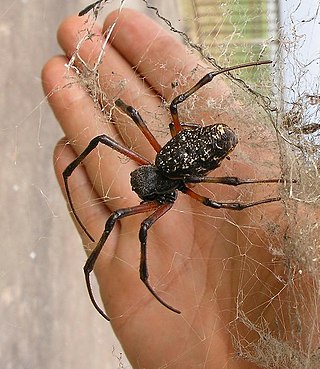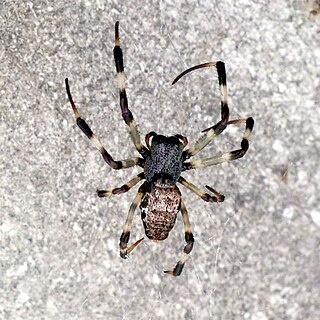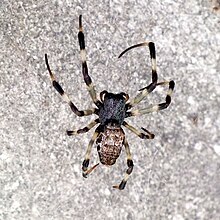
Orb-weaver spiders are members of the spider family Araneidae. They are the most common group of builders of spiral wheel-shaped webs often found in gardens, fields, and forests. The English word "orb" can mean "circular", hence the English name of the group. Araneids have eight similar eyes, hairy or spiny legs, and no stridulating organs.

Nephila is a genus of araneomorph spiders noted for the impressive webs they weave. Nephila consists of numerous species found in warmer regions around the world, although some species formerly included in the genus have been moved to Trichonephila. They are commonly called golden silk orb-weavers, golden orb-weavers, giant wood spiders, or banana spiders.

Trichonephila clavipes, commonly known as the golden silk orb-weaver, golden silk spider, golden orb weaver spider or colloquially banana spider, is an orb-weaving spider species which inhabits forests and wooded areas ranging from the southern US to Argentina. It is indigenous to both continental North and South America. Known for the golden color of their silk, the large size of their females, and their distinctive red-brown and yellow coloring, T. clavipes construct large, asymmetrical circular webs attached to trees and low shrubs in woods to catch small- and medium-size flying prey, mostly insects. They are excellent web-builders, producing and utilizing seven different types of silk, and they subdue their prey by injecting them with venom, as opposed to related species which immobilize their prey by wrapping them in silk first. They are not known to be aggressive towards humans, only biting out of self-defense if touched, and their relatively harmless venom has a low toxicity, posing little health concern to healthy human adults. Due to their prevalence in forests, T. clavipes may be encountered by hikers.

Nephila pilipes is a species of golden orb-web spider. It resides all over countries in East and Southeast Asia as well as Oceania. It is commonly found in primary and secondary forests and gardens. Females are large and grow to a body size of 30–50 mm, with males growing to 5–6 mm. It is the second largest of the orb-weaving spiders apart from the recently discovered Nephila komaci. The first, second, and fourth pairs of legs of juvenile females have dense hairy brushes, but these brushes disappear as the spider matures.

Herennia is a genus of spiders in the family Nephilidae, found from India to northern Australia. While two species have been known since the 19th century, nine new species were described in 2005. Spiders in this genus are sometimes called coin spiders.

Nephilingis cruentata is an nephilid spider with a strikingly red sternum.

Nephilingis borbonica is an nephilid spider from Réunion. It was once thought to also inhabit Madagascar and other nearby islands, however these were determined in 2011 to be a different species, Nephilingis livida, while specimens from Mauritius were placed in the new species Nephilingis dodo.

Nephilengys malabarensis is an nephilid spider.

Nephilengys papuana is a species of nephilid spider.

Phonognatha graeffei, referred to as the leaf curling spider, is a common Australian spider found in woodlands and urban areas in the northeastern, eastern and southern states. A member of the family Araneidae, the orb-weavers, it was previously placed in Tetragnathidae.

Darwin's bark spider is an orb-weaver spider that produces the largest known orb webs, ranging from 900 to 28,000 square centimetres, with bridge lines spanning up to 25 metres (82 ft). The spider was discovered in Madagascar in the Andasibe-Mantadia National Park in 2009. Its silk is the toughest biological material ever studied. Its tensile strength is 1.6 GPa. The species was named in honour of the naturalist Charles Darwin on November 24, 2009—precisely 150 years after the publication of The Origin of Species.

Mongolarachne is an extinct genus of spiders placed in the monogeneric family Mongolarachnidae. The genus contains only one species, Mongolarachne jurassica, described in 2013, which is presently the largest fossilized spider on record. The type species was originally described as Nephila jurassica and placed in the living genus Nephila which contains the golden silk orb-weavers.

Nephilingis livida is an nephilid spider from Madagascar and nearby islands. It was found to be separate from the related species Nephilingis borbonica in 2011
Nephilingis dodo is an nephilid spider endemic to Mauritius. It was found to be separate from the related species Nephilingis borbonica in 2011.

Herennia multipuncta, commonly known as the spotted coin spider, is a species of spider in the family Nephilidae native to Asia. It exhibits sexual dimorphism, the female being much larger than the male. It weaves a small web on the trunk of a tree or the wall of a building and is well camouflaged by its dappled colouration.

Caerostris, sometimes called bark spiders, is a genus of orb-weaver spiders first described by Tamerlan Thorell in 1868. Most species are found in south eastern Africa and neighboring Madagascar.

Nephilingis is a genus of spiders in the family Nephilidae. It was split off from the genus Nephilengys in 2006. Both genera have been called hermit spiders from the habit of staying in their retreats during the day; alternatively the name "hermit spider" may be reserved for Nephilingis, with Nephilengys species called "eunuch spiders".

Nephilidae is a spider family commonly referred to as golden orb-weavers. The various genera in the Nephilidae family were formerly placed in Tetragnathidae and Araneidae. All nephilid genera partially renew their webs.

Artifex melanopyga, synonym Phonognatha melanopyga, referred to as a leaf curling spider, is a common Australian spider found in moist coastal areas of New South Wales and Queensland. A small member of the family Araneidae, the orb-weavers, it was previously placed in Tetragnathidae.

Trichonephila is a genus of golden orb-weaver spiders that was first described by Friedrich Dahl in 1911, as a subgenus of Nephila. Trichonephila was elevated to the level of genus by Kuntner et al. in 2019. The genus Trichonephila belongs to the Nephilidae family.


















